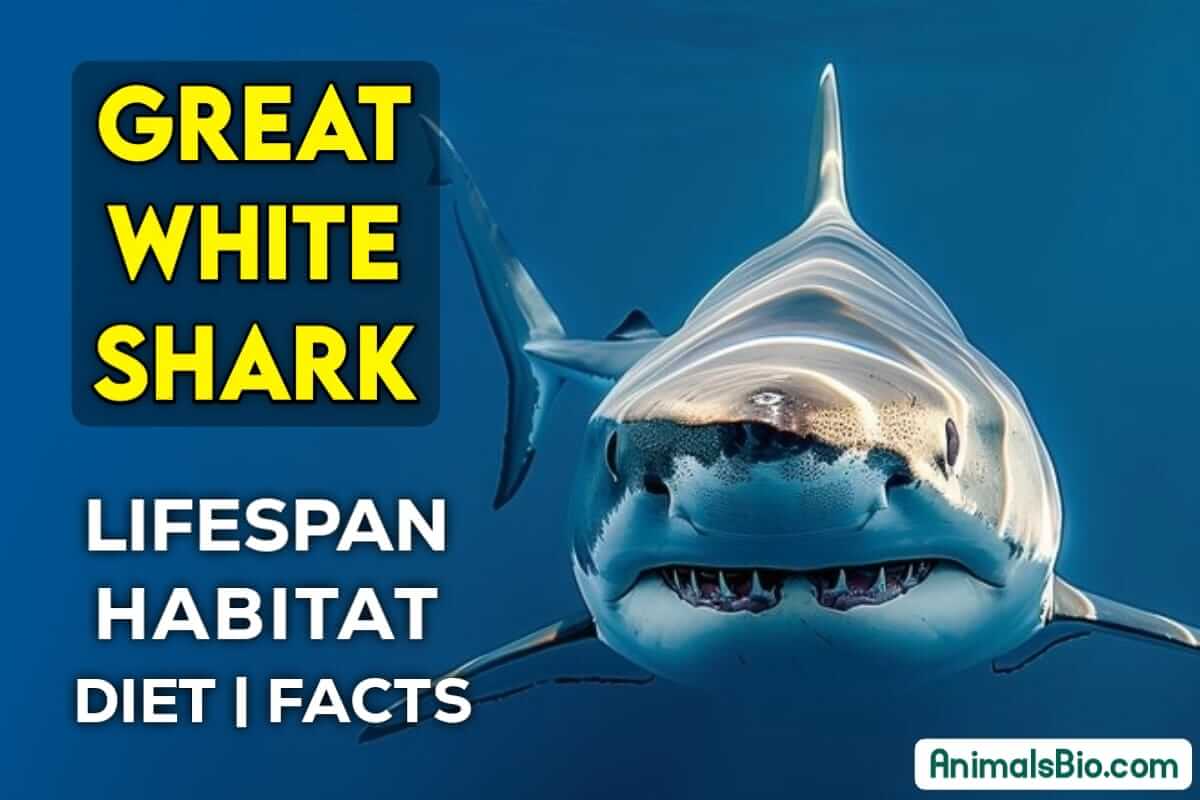The great white shark, which is frequently seen as the most terrifying predator in the ocean, has been both fascinating and frightening to people for many years.
Which is known scientifically as Carcharodon carcharias, the great white shark is often just seen as a scary character in movies, but in reality, it is a smart and intricate creature that plays an essential role in keeping the ocean’s ecosystems healthy and balanced.
In this article, we’ll take a closer look at the life of the great white shark. We’ll learn about how long they live, where they can be found, what they eat, and how they hunt. Additionally, we will discover some interesting and lesser-known facts about their unique features that really make them stand out.
Great White Shark Lifespan and Growth
Great white sharks can live for a surprisingly long time, with an average lifespan of around 30 years, although some have been known to live up to 70 years or more. They grow quite slowly, and it takes a long time for them to be able to reproduce.
Male great white sharks are about 15 years old when they reach sexual maturity, and females take even longer, usually over 20 years. Because it takes them so long to mature and they don’t have many babies, their populations can be quite vulnerable to different kinds of threats.
These threats can come from nature or can be caused by humans. This makes it important to be careful about how human activities might affect them.
Great White Shark Habitat – Where they Live

The great white shark is known for traveling long distances and can be found in both coastal and deep-sea waters around the world, particularly in regions with temperate to subtropical climates.
They are often seen near the coasts of places like California in the United States, South Africa, Australia, New Zealand, Japan, and even the Mediterranean Sea. Great white sharks prefer cooler waters, which suits their unique ability as endothermic animals.
This means they can regulate their body temperature to keep it warmer than the water around them. Having this ability gives them an advantage over their prey, making them more efficient hunters in their chilly habitats.
This capability to stay warmer than their environment is a key factor in their survival and effectiveness as predators in various marine settings around the globe.
Suggested Article : Tiger Shark Lifespan, Habitat, Diet, Interesting Facts
Great White Shark Diet and Predatory Behavior
The great white shark has a diet that is as varied as the places it lives in. These sharks are particularly known for eating a lot of marine mammals like seals, sea lions, and sometimes even small whales.
But they don’t just eat large mammals; their diet also includes fish, rays, and other sharks. What a great white shark eats can change a lot depending on where it is and what kind of food is available there.
This shows how adaptable they are and how they can take advantage of different feeding opportunities. Their ability to eat such a wide range of prey helps them to thrive in many different ocean environments around the world.
Great White Shark Hunting Techniques

Great white sharks are highly skilled hunters, having developed several adaptations that position them as top predators in the ocean. One of their key advantages is their coloration; their grey tops blend seamlessly with the deep waters when viewed from above, allowing them to approach prey unnoticed.
A striking hunting tactic they employ, especially noted in South Africa, is known as “breaching.” This involves the shark making a swift, vertical surge from below to catch its prey by surprise, often resulting in both the shark and its prey dramatically leaping out of the water.
In terms of physical prowess, great white sharks possess a formidable bite force. Their mouths are equipped with multiple rows of large, serrated teeth that can be continually replaced throughout their lifetime.
When hunting larger prey, they often deliver a powerful and potentially fatal bite and then retreat, allowing their prey to weaken from blood loss. This wait-and-return tactic is not just effective but also helps the shark avoid injuries from prey that might struggle.
This combination of stealth, power, and strategic hunting makes the great white shark a supreme predator in its marine environment.
Suggested Article : Komodo Dragon Hunting Skills
Great White Shark Conservation Status
Despite often being seen as the untouchable giants of the ocean, great white sharks are actually considered vulnerable and are listed as such by the International Union for Conservation of Nature (IUCN).
They face numerous threats that jeopardize their survival, including becoming accidentally caught in fishing gear, being hunted for their jaws and fins, and suffering from the effects of pollution.
These factors are particularly troubling given that great white sharks reproduce slowly, making it hard for their populations to recover from declines.
Conservation efforts are therefore essential to help protect these magnificent creatures. Various marine organizations are actively involved in tracking and researching great white sharks, which is crucial for understanding their life patterns and migration behaviors.
This ongoing work is vital in aiding their conservation, helping to develop strategies that can mitigate the threats they face and ensure they remain a thriving part of the ocean ecosystem.
Fun Facts About Great White Shark

lectromagnetic Field Detection: Great white sharks, like all sharks, have a special ability to detect electromagnetic fields produced by other creatures. This is possible thanks to their specialized sensory organs called the ampullae of Lorenzini.
With these organs, great white sharks can sense the presence of prey, even if the prey is hidden under the sand or in cloudy, murky water. This incredible skill helps them find food in difficult conditions.
Temperature Regulation: Great white sharks have a unique ability unlike most fish: they can regulate their body temperature. This adaptation allows them to maintain a warmer body temperature compared to the cold waters they often inhabit.
This capability is particularly advantageous because it helps them thrive in colder environments and gives them a critical edge when hunting in deep or cold waters. This temperature control is essential for their survival and success as predators.
Cultural Impact: The great white shark has made a significant impact on culture, mainly due to its fearsome reputation, which was heightened by movies like “Jaws.” While these movies have portrayed it as a terrifying creature, this image has also sparked a widespread interest in sharks.
As a result, there has been increased funding and attention toward shark conservation efforts, aiming to protect these misunderstood animals.
Conservation Importance: Great white sharks play a critical role in marine ecosystems as apex predators. By controlling the population of their prey, such as seals, they help maintain the health and balance of the ecosystem.
This natural form of population control ensures that no single species dominates the environment, which is crucial for the overall health and diversity of ocean life. Their presence helps keep marine ecosystems functioning properly, underscoring their importance in conservation efforts.
Conclusion
The great white shark remains one of the ocean’s most impressive and misunderstood creatures. Through ongoing research and conservation, our understanding of this magnificent predator continues to grow, helping to shift the narrative from fear to fascination and respect.
Protecting these creatures is not just about saving a single species but about maintaining the balance of marine ecosystems on which human health and survival depend.
As apex predators, great whites play an indispensable role in the natural order of marine life, and their conservation is essential for the health of our oceans.
sources
Wikipedia Org
ifaw Org
Frequently Asked Questions (FAQ)
How Big Can a Great White Shark Get ?
Great white sharks can grow very large, typically reaching lengths of 15 to 20 feet. However, some exceptional individuals have been recorded at lengths of up to 20 feet or more.
How Fast is a Great White Shark ?
Great white sharks are powerful swimmers and can reach speeds of up to 25 miles per hour (40 kilometers per hour) in short bursts when they are hunting or need to escape a threat. This speed makes them one of the fastest and most efficient predators in the ocean.
What do Great White Shark Eat ?
Great white sharks are apex predators with a diverse diet. They primarily feed on marine mammals like seals, sea lions, and small whales.
They also eat other fish, including smaller sharks and rays, as well as squid and crustaceans. Occasionally, they may consume seabirds too. Their diet varies depending on the availability of prey in their current habitat.
How Many Teeth does a Great White Shark have ?
A great white shark has about 300 teeth, arranged in several rows in their mouths. These teeth are triangular, serrated, and very sharp, designed for cutting and tearing flesh.
As teeth are lost, broken, or worn down, they are continuously replaced by new ones throughout the shark’s life.
Where do Great White Sharks live ?
Great white sharks live in coastal and offshore waters all around the world, especially in cooler waters. You can find them in the oceans near the United States, South Africa, Australia, New Zealand, Japan, and the Mediterranean Sea.
How long can a Great White Shark live ?
Great white sharks can live for about 30 years, but some have been known to live up to 70 years. Their lifespan can vary depending on factors like their environment, availability of food, and threats from human activities.






